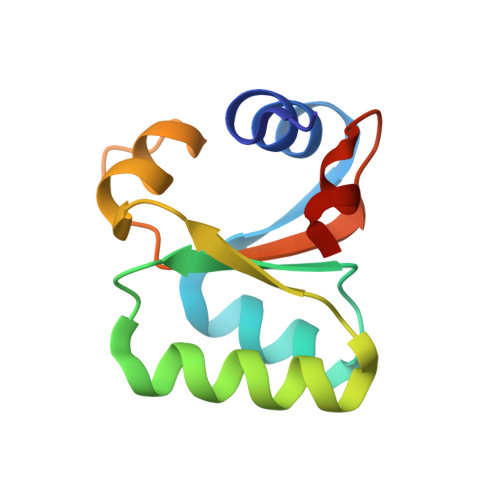Electrostatic Interactions Contribute to Reduced Heat Capacity Change of Unfolding in a Thermophilic Ribosomal Protein L30E
Lee, C.F., Allen, M.D., Bycroft, M., Wong, K.B.(2005) J Mol Biol 348: 419
- PubMed: 15811378
- DOI: https://doi.org/10.1016/j.jmb.2005.02.052
- Primary Citation of Related Structures:
1W40, 1W41, 1W42 - PubMed Abstract:
The origin of reduced heat capacity change of unfolding (DeltaC(p)) commonly observed in thermophilic proteins is controversial. The established theory that DeltaC(p) is correlated with change of solvent-accessible surface area cannot account for the large differences in DeltaC(p) observed for thermophilic and mesophilic homologous proteins, which are very similar in structures. We have determined the protein stability curves, which describe the temperature dependency of the free energy change of unfolding, for a thermophilic ribosomal protein L30e from Thermococcus celer, and its mesophilic homologue from yeast. Values of DeltaC(p), obtained by fitting the free energy change of unfolding to the Gibbs-Helmholtz equation, were 5.3 kJ mol(-1) K(-1) and 10.5 kJ mol(-1) K(-1) for T.celer and yeast L30e, respectively. We have created six charge-to-neutral mutants of T.celer L30e. Removal of charges at Glu6, Lys9, and Arg92 decreased the melting temperatures of T.celer L30e by approximately 3-9 degrees C, and the differences in melting temperatures were smaller with increasing concentration of salt. These results suggest that these mutations destabilize T.celer L30e by disrupting favorable electrostatic interactions. To determine whether electrostatic interactions contribute to the reduced DeltaC(p) of the thermophilic protein, we have determined DeltaC(p) for wild-type and mutant T.celer L30e by Gibbs-Helmholtz and by van't Hoff analyses. A concomitant increase in DeltaC(p) was observed for those charge-to-neutral mutants that destabilize T.celer L30e by removing favorable electrostatic interactions. The crystal structures of K9A, E90A, and R92A, were determined, and no structural change was observed. Taken together, our results support the conclusion that electrostatic interactions contribute to the reduced DeltaC(p) of T.celer L30e.
Organizational Affiliation:
Molecular Biotechnology Programme, The Chinese University of Hong Kong, Shatin, Hong Kong SAR, China.














